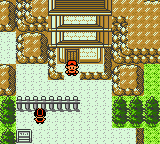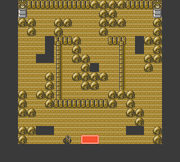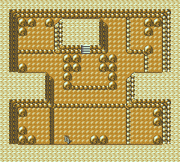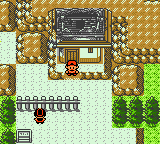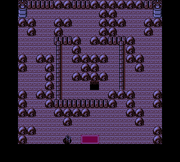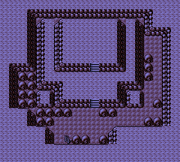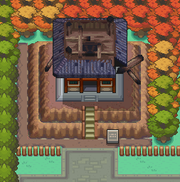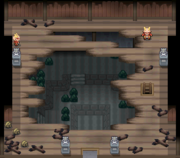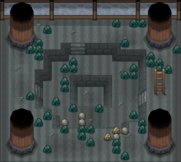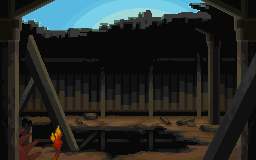|
|
| Line 570: |
Line 570: |
| ==Trivia== | | ==Trivia== |
| * In {{game|Gold and Silver|s}}, the exterior of the Burned Tower depicts it as being a short, common tower. However, in {{v|Crystal}} the top of the tower is destroyed, showing the inside, and the interior uses darker colors to produce a charred look, thus making it more akin to the storyline. The Crystal exterior design was then updated and reused in {{game|HeartGold and SoulSilver|s}}, while the interior combines elements of both designs from [[Generation II]]. | | * In {{game|Gold and Silver|s}}, the exterior of the Burned Tower depicts it as being a short, common tower. However, in {{v|Crystal}} the top of the tower is destroyed, showing the inside, and the interior uses darker colors to produce a charred look, thus making it more akin to the storyline. The Crystal exterior design was then updated and reused in {{game|HeartGold and SoulSilver|s}}, while the interior combines elements of both designs from [[Generation II]]. |
| | * In Pokémon Gold and Silver, after you defeat Firebreather Dick, his overworld sprite loses color, becoming grayscale. |
| * In Pokémon Crystal, because {{ga|Silver}} doesn't battle the player immediately after entering the Burned Tower, the player can enter the tower and speak with [[Eusine]], and see that Silver is in the middle of the tower, waiting for the player. However, if the player leaves and proceeds to [[Olivine City]], when the player arrives Silver appears there, exiting the [[Olivine Gym]], and then talks to the player before leaving. If the player returns to the Burned Tower, Silver will still be waiting for the player there. | | * In Pokémon Crystal, because {{ga|Silver}} doesn't battle the player immediately after entering the Burned Tower, the player can enter the tower and speak with [[Eusine]], and see that Silver is in the middle of the tower, waiting for the player. However, if the player leaves and proceeds to [[Olivine City]], when the player arrives Silver appears there, exiting the [[Olivine Gym]], and then talks to the player before leaving. If the player returns to the Burned Tower, Silver will still be waiting for the player there. |
| * The music used in the Burned Tower is a slower, more melancholic version of the theme of the Bell Tower, indicating their connection. | | * The music used in the Burned Tower is a slower, more melancholic version of the theme of the Bell Tower, indicating their connection. |
Burned Tower
Brass Tower
|
|
やけたとう
Burned Tower
|
| "Wild Missingno. appeared!"
|
|
|
|
| Map description:
|
A tower that was hit by lightning, and subsequently caught fire and burned.
|
| Location:
|
Ecruteak City
|
| Region:
|
Johto
|
| Generations:
|
II, IV
|
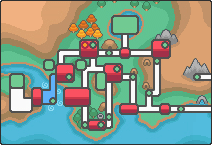
Location of Burned Tower in Johto.
|
| Pokémon world locations
|
The Burned Tower (Japanese: やけたとう Burned Tower) is a location in Ecruteak City formerly as tall as the Bell Tower to the east. It burned down mysteriously 150 years prior to the events of the Pokémon Gold, Silver, and Crystal and their remakes. Before the great fire that caused its destruction the tower was called Brass Tower (Japanese: かねのとう Metal Tower).
According to some legends, Lugia once perched here. However, when the tower burned down, Lugia fled to the Whirl Islands to live, while Ho-Oh, which lived in the Bell Tower, flew away in search of a pure-hearted Trainer. Three unnamed Pokémon perished in the fire; Ho-Oh returned briefly to revive them after the fire had been put out. These Pokémon, the Legendary beasts Raikou, Entei, and Suicune, were destined to speed across the land since their revival.
In the games

The beasts in the Burned Tower in HeartGold and SoulSilver
In Pokémon Gold, Silver, Crystal, HeartGold, and SoulSilver, the player encounters Raikou, Entei, and Suicune for the first time in the basement of the Burned Tower, who then flee. This is also where the player's rival will challenge him or her once again, with the second form of the starter he stole.
In Crystal, it is said that, before it burned down, the tower was known as the Brass Tower, with gleaming golden panels of brass to complement the Tin Tower's silvery panels of tin. However, this detail was not mentioned in the remakes, and the Tin Tower's name was changed to "Bell Tower", removing any connection the two had to the names of the games.
History
The tower was built 700 years before the time of Generations II and IV alongside its twin, the Bell Tower. The two towers were meant to foster friendship between people and Pokémon. Many people, mostly ancestors of Ecruteak Gym Leader Morty, traveled to the tops of these towers to commune with the Legendary Pokémon residing there.
Suddenly, 150 years before the events of the games, this tower burned down in a mysterious fire, ignited by a bolt of lightning and put out by a sudden downpour. This fire, which may have had some relation to the drought that a Slowpoke ended in Azalea Town, caused three nameless Pokémon to perish. Ho-Oh, fleeing from its perch, granted new life to the Pokémon, making them into the Legendary beasts before flying in search of a pure-hearted Trainer. The three events of the fire, the lightning bolt, raging blaze, and sudden downpour, are said to have some relation to the three beasts.
Items
Pokémon
Generation II
1F
| Pokémon
|
Games
|
Location
|
Levels
|
Rate
|
|
|
G
|
S
|
C
|

|
1F
|
|
13-15
|
50%
|
|
|
G
|
S
|
C
|

|
1F
|
|
13-15
|
55%
|
|
|
G
|
S
|
C
|

|
1F
|
|
15
|
5%
|
|
|
G
|
S
|
C
|

|
1F
|
|
14
|
10%
|
|
|
G
|
S
|
C
|

|
1F
|
|
14-16
|
35%
|
|
|
G
|
S
|
C
|

|
1F
|
|
14
|
30%
|
| Rock Smash
|
|
|
G
|
S
|
C
|
|
15
|
90%
|
|
|
G
|
S
|
C
|
|
15
|
10%
|
| A colored background means that the Pokémon can be found in this location in the specified game. A white background with a colored letter means that the Pokémon cannot be found here.
|
B1F
| Pokémon
|
Games
|
Location
|
Levels
|
Rate
|

|

|

|
|
|
G
|
S
|
C
|

|
B1F
|
|
14-16
|
40%
|
35%
|
40%
|
|
|
G
|
S
|
C
|

|
B1F
|
|
14
|
30%
|
|
|
G
|
S
|
C
|

|
B1F
|
|
15
|
5%
|
|
|
G
|
S
|
C
|

|
B1F
|
|
15
|
10%
|
|
|
G
|
S
|
C
|

|
B1F
|
|
14-16
|
50%
|
|
|
G
|
S
|
C
|

|
B1F
|
|
12-16
|
59%
|
|
|
G
|
S
|
C
|

|
B1F
|
|
16
|
1%
|
|
|
G
|
S
|
C
|

|
B1F
|
|
14
|
5%
|
0%
|
5%
|
|
|
G
|
S
|
C
|

|
B1F
|
|
16
|
0%
|
10%
|
0%
|
| A colored background means that the Pokémon can be found in this location in the specified game. A white background with a colored letter means that the Pokémon cannot be found here.
|
Generation IV
1F
| Pokémon
|
Games
|
Location
|
Levels
|
Rate
|
|
|
HG
|
SS
|

|
1F
|
|
13-15
|
50%
|
|
|
HG
|
SS
|

|
1F
|
|
15
|
5%
|
|
|
HG
|
SS
|

|
1F
|
|
14
|
10%
|
|
|
HG
|
SS
|

|
1F
|
|
14-16
|
35%
|
| Special Pokémon
|
|
|
HG
|
SS
|
|
13-14
|
20%
|
|
|
HG
|
SS
|
|
15
|
20%
|
|
|
HG
|
SS
|
|
15
|
20%
|
|
|
HG
|
SS
|
|
14
|
20%
|
| A colored background means that the Pokémon can be found in this location in the specified game. A white background with a colored letter means that the Pokémon cannot be found here.
|
B1F
| Pokémon
|
Games
|
Location
|
Levels
|
Rate
|

|

|

|
|
|
HG
|
SS
|

|
B1F
|
|
14-16
|
40%
|
0%
|
40%
|
|
|
HG
|
SS
|

|
B1F
|
|
14
|
0%
|
35%
|
0%
|
|
|
HG
|
SS
|

|
B1F
|
|
15
|
5%
|
|
|
HG
|
SS
|

|
B1F
|
|
14-16
|
50%
|
|
|
HG
|
SS
|

|
B1F
|
|
14
|
5%
|
0%
|
5%
|
|
|
HG
|
SS
|

|
B1F
|
|
16
|
0%
|
10%
|
0%
|
| Special Pokémon
|
|
|
HG
|
SS
|

|
Only one
|
|
40
|
One
|
|
|
HG
|
SS
|
|
14
|
20%
|
|
|
HG
|
SS
|
|
16
|
20%
|
|
|
HG
|
SS
|
|
16
|
20%
|
|
|
HG
|
SS
|
|
14
|
20%
|
| A colored background means that the Pokémon can be found in this location in the specified game. A white background with a colored letter means that the Pokémon cannot be found here.
|
Trainers
Generation II
 If the player chose Chikorita:
If the player chose Chikorita:

|
|
Reward: $1320
|
|
|
|
|
|
 If the player chose Cyndaquil:
If the player chose Cyndaquil:

|
|
Reward: $1320
|
|
|
|
|
|
 If the player chose Totodile:
If the player chose Totodile:

|
|
Reward: $1320
|
|
|
|
|
|
| Trainer
|
Pokémon
|
| Requires Rock Smash
|
|
|
|
|
|
|
|
|
|
|
|
|
| Trainers with a telephone symbol by their names will give their Pokégear number to the player, and may call or be called for a rematch with higher-level Pokémon.
|
Generation IV
 If the player chose Chikorita:
If the player chose Chikorita:

|
|
Reward: $1408
|
|
|
|
|
|
 If the player chose Cyndaquil:
If the player chose Cyndaquil:

|
|
Reward: $1408
|
|
|
|
|
|
 If the player chose Totodile:
If the player chose Totodile:

|
|
Reward: $1408
|
|
|
|
|
|
| Trainer
|
Pokémon
|
|
|
|
|
|
|
|
|
|
|
|
|
| Trainers with a telephone symbol by their names will give their Pokégear number to the player, and may call or be called for a rematch with higher-level Pokémon.
|
Layout

|
This section is incomplete.
Please feel free to edit this section to add missing information and complete it.
Reason: 1F layout in Pokémon Crystal before the hole in the center and the ladder appears
|
In the anime
In the main series

The Burned Tower in the anime

The Burned Tower in its debut
The Burned Tower exists in the anime's interpretation of Ecruteak City as well, however, it was the only tower initially, and was the Bell Tower itself. When it burned down due to a war for Ho-Oh's power, a second, new Bell Tower was built to the east, in the hope that Ho-Oh would return, though it never did.
In A Ghost of a Chance, Ash, Misty, and Brock traveled to the Burned Tower by accident, thinking it was the Ecruteak Gym. While here, they were frightened by the many Gastly who took up residence here, as they had made an illusion of fire. With Morty's help, they were able to calm down the ghosts and get out.
The Burned Tower later made a brief cameo in An Egg Scramble! during Lyra's presentation of Johto at the Johto Festival.
In Pokémon Generations

Brass Tower in Pokémon Generations
The Burned Tower appeared in The Reawakening, where Eusine went over the legend of the Legendary beasts while exploring the tower. He also had a momentary encounter with Suicune, making him hopeful that the Legendary beasts would start trusting in humans again.
The Brass Tower was also seen in a flashback during Eusine's tale before it burned.
In the manga
In the Pokémon Adventures manga
The ruined tower is briefly seen in Slugging It Out With Slugma, where three balls of light are seen flying out of the building.
In Buzz Off, Butterfree! the events seen at the end of the previously mentioned round are shown in more detail. When Yellow and Wilton pass through Ecruteak City, they meet Jasmine with whom they talk about things related to the earthquake that struck the city not too long ago. While they discuss, the Burned Tower catches fire. Yellow puts the fire out but is pulled into the tower. She is about to hit a rock inside the tower but, to her great surprise, goes through it. She finds herself in an unknown place and meets Entei, Raikou, and Suicune. The three Pokémon thank her for freeing them, after which they take off. After Yellow gets out from the rock she tells Jasmine and Wilton what she saw. Jasmine then tells her and Wilton the story behind the ruined tower and the Legendary beasts.

The stadium where the
Pokémon Summit is held, located on the site of the Burned Tower

The Burned Tower in Pocket Monsters HGSS Jō's Big Adventure
In the Pokémon Gold & Silver: The Golden Boys manga
In Pokémon Gold & Silver: The Golden Boys, the legend passed down in Ecruteak City is that Brass Tower was burned down intentionally by people long ago, as they felt they had lost their connection to the Legendary Pokémon it was built to honor. As a result, the golden Pokémon returned to the skies and broke all ties with humankind.
Unlike in the games, there are no ruins where the Burned Tower used to stand. Instead, a stadium was built on the site of the tower. It is used to house the Pokémon Summit.
In the Pocket Monsters HGSS Jō's Big Adventure manga
The Burned Tower appeared in JBA3.
In the TCG
The following is a list of cards named Burned Tower.
Trivia
- In Pokémon Gold and Silver, the exterior of the Burned Tower depicts it as being a short, common tower. However, in Crystal Version the top of the tower is destroyed, showing the inside, and the interior uses darker colors to produce a charred look, thus making it more akin to the storyline. The Crystal exterior design was then updated and reused in Pokémon HeartGold and SoulSilver, while the interior combines elements of both designs from Generation II.
- In Pokémon Gold and Silver, after you defeat Firebreather Dick, his overworld sprite loses color, becoming grayscale.
- In Pokémon Crystal, because Silver doesn't battle the player immediately after entering the Burned Tower, the player can enter the tower and speak with Eusine, and see that Silver is in the middle of the tower, waiting for the player. However, if the player leaves and proceeds to Olivine City, when the player arrives Silver appears there, exiting the Olivine Gym, and then talks to the player before leaving. If the player returns to the Burned Tower, Silver will still be waiting for the player there.
- The music used in the Burned Tower is a slower, more melancholic version of the theme of the Bell Tower, indicating their connection.
- The tower's original name of "Brass Tower" is only referenced once, in Crystal.
- After the player has captured or defeated Ho-Oh in HeartGold and SoulSilver, several citizens of Ecruteak mention that there are plans to rebuild the tower.
- It is actually possible to use Dig to escape from the Burned Tower—even the basement—and return to the entrance; this is because, as can be seen from the in-battle background used in Generation IV, the Burned Tower is classified as a cave area, rather than a building, likely to allow wild Pokémon to be found. This is also the case with the Bell Tower and Sprout Tower.
- Due to this, unlike other buildings, Burmy will take on its Sandy Cloak, rather than its Trash Cloak, if it battles here.
Origin
A Buddhist temple in the real world city of Kyoto, covered in gold leaf, is known as Kinkaku-ji. Like this tower, it was burned down; however, unlike it, it was reconstructed. The likeness of a phoenix rests atop the tower.
Name origin
While the Burned Tower is named quite obviously in both English and Japanese, the original Japanese name of the tower, revealed in Pokémon Crystal, was かねのとう Kane no Tou. "Kane" can be translated as "metal", hence the English version's translation as Brass Tower, a golden-colored metal, to counter the silver-colored tin used on the other tower. "Kane" can also, like the suzu of the Bell Tower, translate as a type of gong-like bell used in Japanese ritual. As it was not mentioned in HeartGold and SoulSilver, it did not receive a more accurate name as Bell Tower did.
In other languages
Bronze Tower
See also

 If the player chose Chikorita:
If the player chose Chikorita:
 If the player chose Cyndaquil:
If the player chose Cyndaquil:
 If the player chose Chikorita:
If the player chose Chikorita:
 If the player chose Cyndaquil:
If the player chose Cyndaquil:

